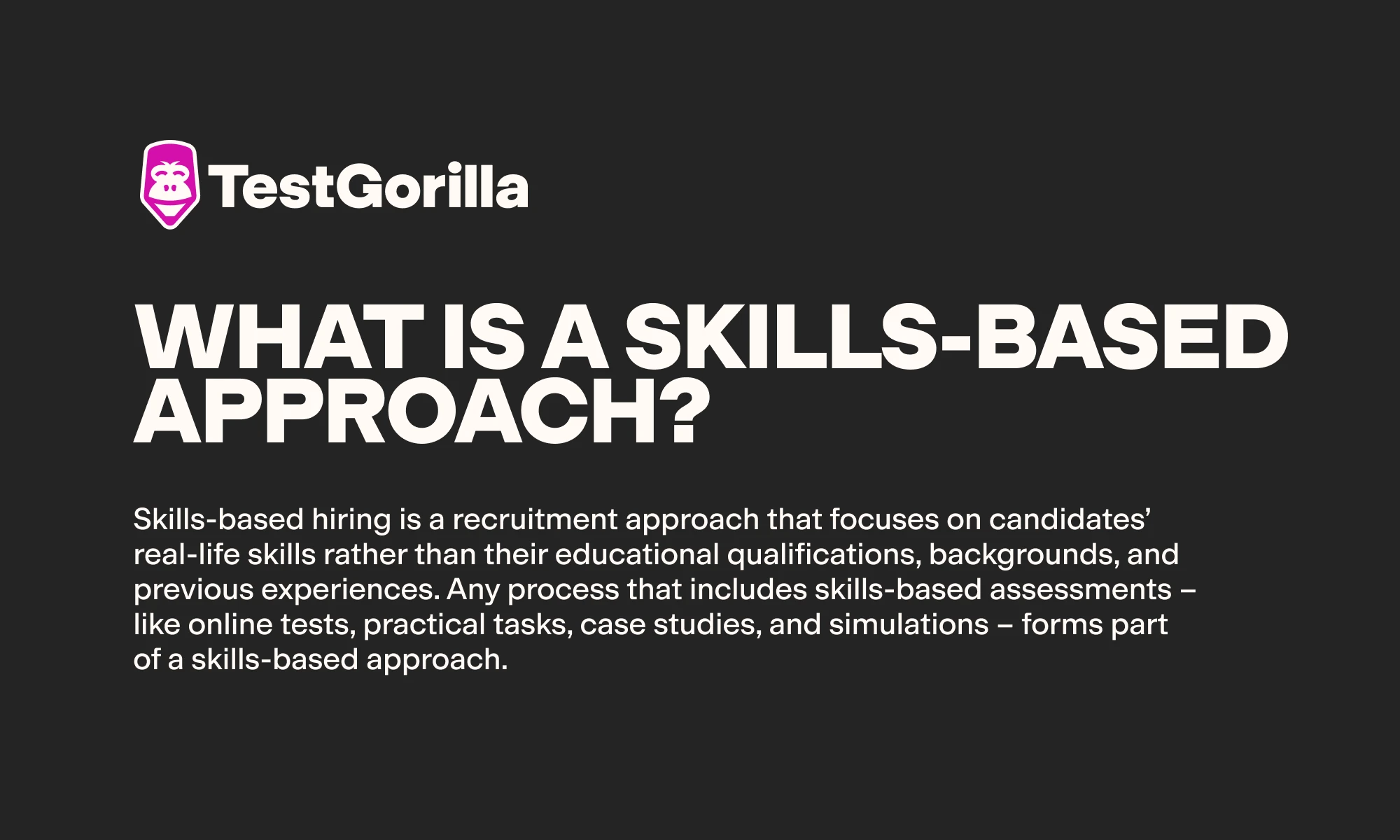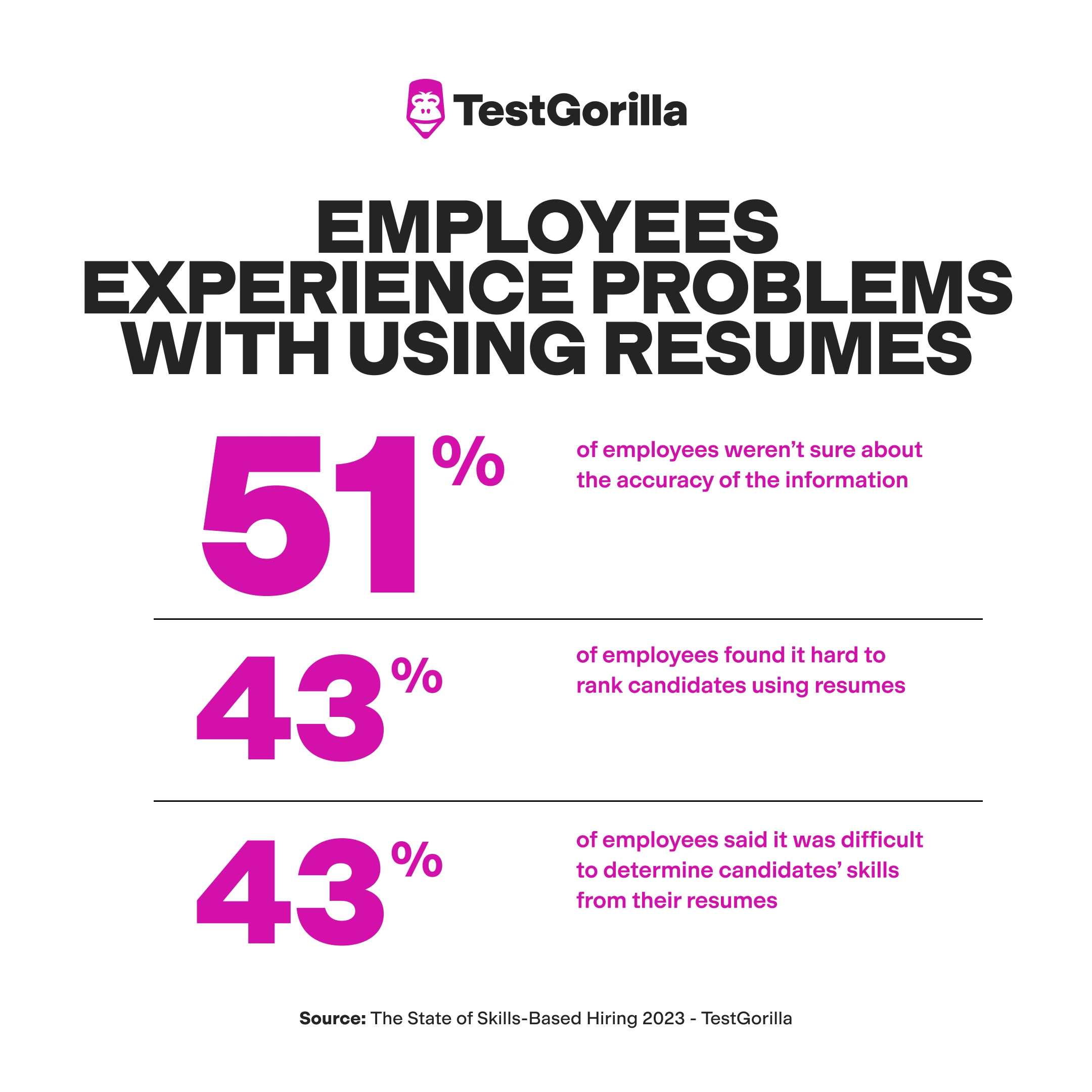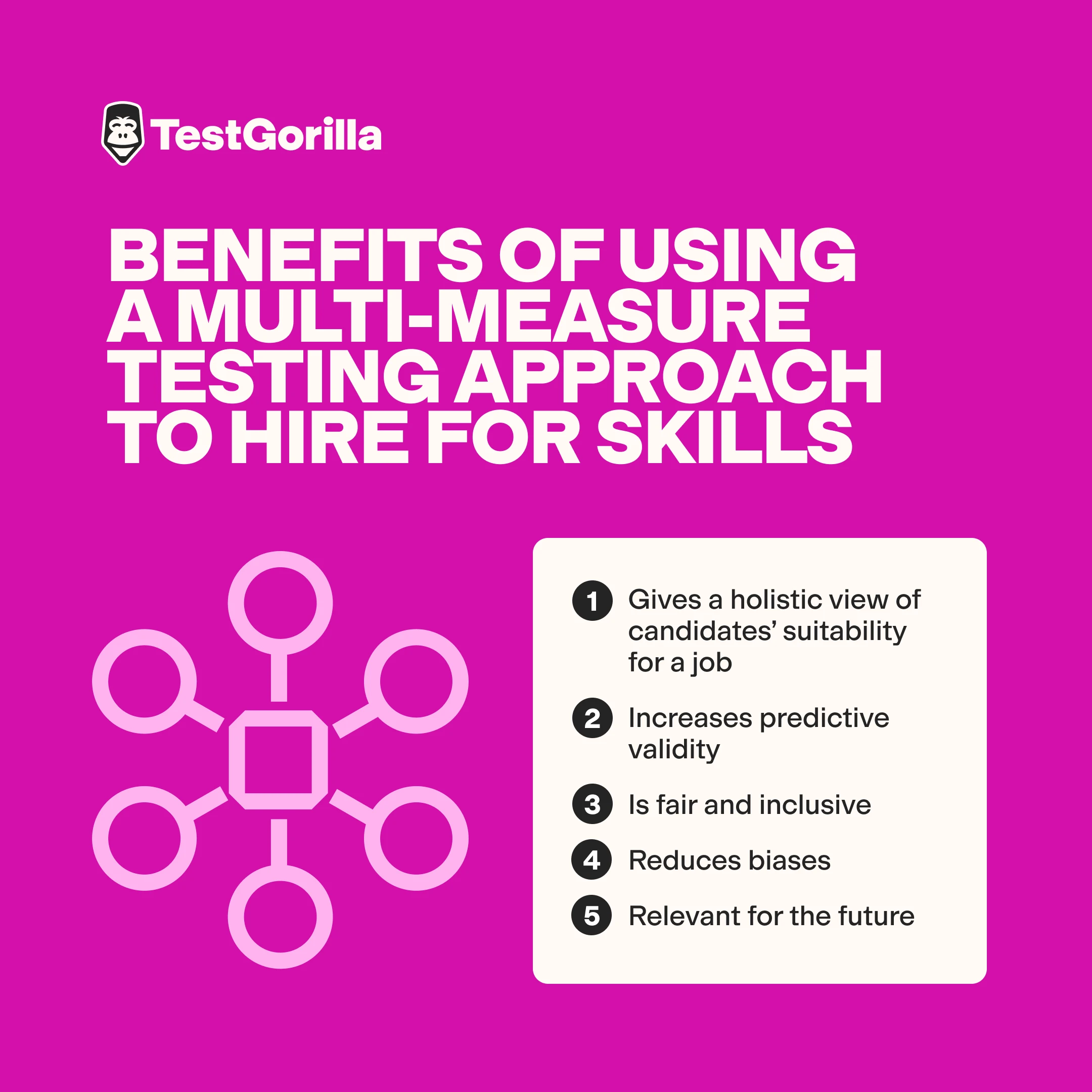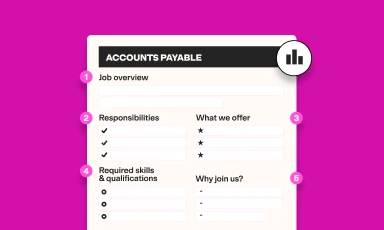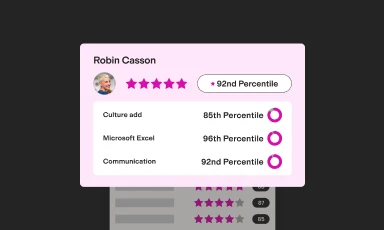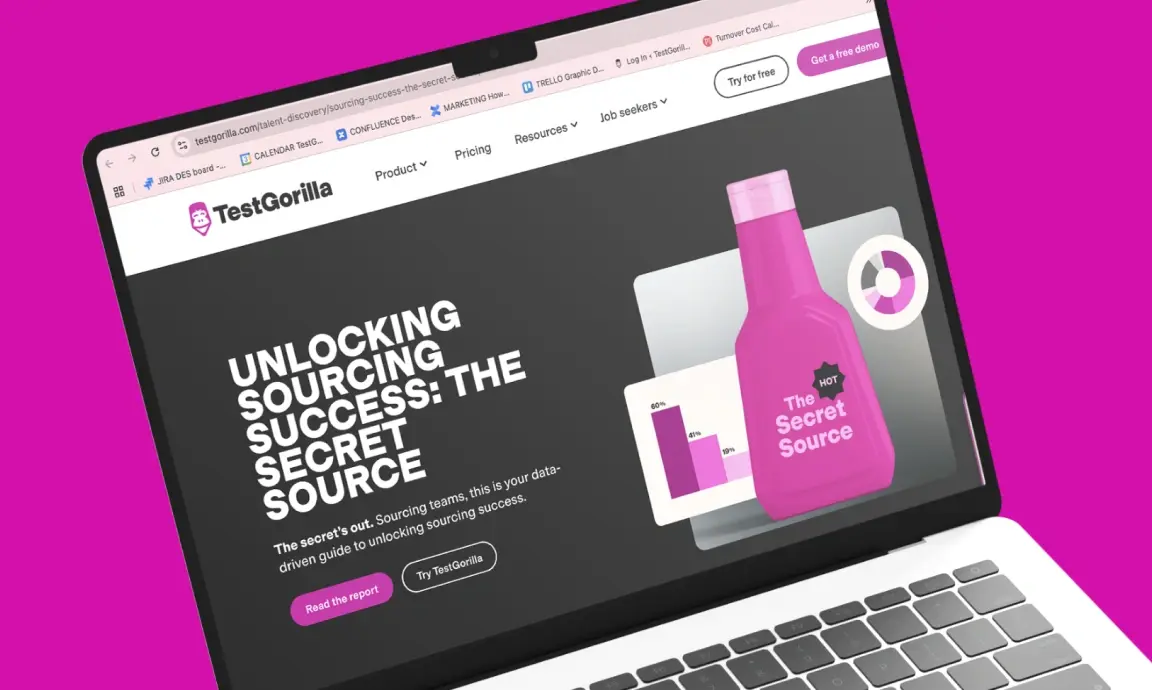4 simple ways to master skills-based hiring
For many employers, skills-based hiring has been a game-changer. It's helped them find top talent, boost diversity, and save time and money – despite an unfavorable job market.
Unfortunately, not everyone is seeing these benefits, and we get how frustrating it can be. You’ve got the best intentions. Maybe you’re using tried and tested skills-based practices. Overall, you’re trying to change how you hire – and somehow, you’re still falling short.
Don’t worry, though – we've got your back. We did some solid research to understand what’s happening. In this article, we break it all down for you and share four proven ways to help you hire better, faster, and cheaper with a skills-based approach.
What is a skills-based approach?
Skills-based hiring is a recruitment approach that focuses on candidates’ real-life skills rather than their educational qualifications, backgrounds, and previous experiences. Any process that includes skills-based assessments – like online tests, practical tasks, case studies, and simulations – forms part of a skills-based approach.
Why is skills-based hiring on the rise?
We recently surveyed over 1,000 employers and employees and found that skills-based hiring is officially the number one way to recruit, with 81% of employers now using it. Ninety-five percent also believe it’s the dominant recruitment method of the future. Here’s why:
Skills-based assessments give employers hard, factual evidence for making data-driven decisions.
By focusing on someone’s skills rather than their background, employers can eliminate unconscious biases and hiring discrimination from the hiring process.
Prioritizing skills over degrees can open doors to STARs – those skilled through to alternative routes – widening access to top talent and improving diversity.
Jarir Millah, Human Resources Manager at Ling, summed it up nicely:
This process enables us to prioritize abilities over pedigree, which supports our strong focus on diversity and inclusion. It allows us to review candidates from various backgrounds, not just those who have come from “brand-name” companies.
Our latest study found that by putting skills first, 90% of employers saw a reduction in mis-hiring, and 91% saw improved employee retention.
That said, while most employers seem to be leaning into a skills-based approach, not everyone is maximizing the benefits of skills-based hiring yet...
Some data suggests that employers and some state governments are eliminating degree requirements and shifting their focus to skills-based recruiting. However, a recent study by the Burning Glass Institute and Harvard Business School showed there’s been no real change in how employers hire, with only one in 700 applicants genuinely benefitting from the opportunities that skills-based hiring promises.
So, it’s time to put the focus not just on adopting skills-based hiring but also on doing it right.
What’s going wrong with your skills-based approach?
Here’s what could be stopping you from mastering skills-based hiring and seeing the full range of benefits it can offer.
You’re still obsessed with degrees
Our latest report shows that despite most employers claiming to use a skills-based approach, their views have taken somewhat of a u-turn when it comes to the need for college degrees.
Fifty-nine percent of respondents said college degrees were more important than five years ago, and 70% haven’t removed degree requirements from their job listings.
Yet college enrollment rates are dropping. And studies have shown that a college education is more accessible to White adults and well-connected elites. With that, more candidates from different walks of life are skilling themselves through alternative routes, such as on-the-job learning and online courses.
By leaving degree requirements in your job postings, you’re effectively rejecting all non-degreed applicants before you can put their skills to the test. This defeats the purpose of skills-based hiring by limiting your talent pool, hampering diversity, and causing mis-hiring.
Resumes are still very much in the picture
Last year, we surveyed over 1,500 employers and found that 87% experienced problems with using resumes:
51% weren’t sure about the accuracy of the information.
43% found it hard to rank candidates using resumes.
43% said it was difficult to determine candidates’ skills from their resumes.
Forbes also cited a survey showing that 70% of people lie on their resumes.
Despite this, most employers still use resumes – even in their skills-based practice. Unfortunately, this means they’re screening applicants based on what they look like on paper instead of on their real-life abilities and making decisions based on assumptions – not facts.
The hiring process is subject to biases
We surveyed over 1,000 employees earlier this year. Eighty-four percent of employees agree that skills-based hiring helps reduce conscious and unconscious bias in the hiring process. Despite this, 31% still reported experiencing unconscious bias in the hiring process – up 48% from last year.
Look out for these mistakes that can add bias to your skills-based process.
Screening resumes, especially before you use skills-based assessments, can lead to several biases. You could be prone to a similarity or in-group bias, choosing candidates from similar backgrounds – for instance, the same nationality, gender, or even college as you – rather than those who may be better skilled for the job.
Keeping degree requirements might subject you to the halo effect, where you assume that someone from a “good” college will also be good at a job and shortlist them over other candidates with less impressive credentials who could’ve been better fits for the role.
Forgetting to check your tech and AI algorithms can also lead to flawed decision-making. Contrary to popular opinion, biases aren’t limited to humans. AI tools that make screening decisions based on past data have been shown to perpetuate biases.
Additionally, using tools to scan candidates’ profiles or resumes for certain keywords such as “computer science” or “publications” prioritizes degrees over skills, even if you’ve taken degree requirements out of your job description.
That’s not all. Even skills-based keywords like “communication skills” or “Excel skills” can still lead to poor screening decisions because you’re still shortlisting people without verifying their real-world abilities.
You’re using one-dimensional skills testing
Another problem with your skills-based process? You’re focusing only on your candidates' technical skills – neglecting to check for relevant soft skills, cognitive abilities, behavioral attributes, attitudes and motivations, and so on.
Our report showed that 89% of employers think soft skills matter much more than five years ago. Additionally, research by Leadership IQ found that in 89% of cases, hiring failures were a result of candidates’ negative attitudes. Technical skills were a mismatch in only 11% of cases. Focusing solely on the technical skills required for a job can leave you with someone who’s highly skilled but a misfit for your company in every other way.
You’re using manual and time-consuming skills assessments
We asked employers about some of their biggest challenges with adopting skills-based hiring. Thirty-eight percent were concerned about adding an extra step to the hiring process. Meanwhile, 41% said they found it difficult to evaluate assessments from a large number of candidates.
These numbers suggest that employers are using manual and time-consuming processes in their skills-based approaches.
Some might be creating in-house case studies, practical tasks, presentations, and so on. These can take ages to create and roll out. Plus, coming up with objective criteria on which to score candidates’ performance for a fair approach is another time-consuming task.
Others might create their own set of online or in-person skills tests, which is also time-intensive and can lead to flawed or unreliable testing. Finally, even those using ready tests could be scoring them manually.
All the above assessment and evaluation methods suck resources, prevent you from hiring quickly at scale, and lead to scoring and decision-making errors.
Anxious candidates are dropping out of the process
Finally, you could be doing everything else right but losing candidates who aren’t so keen on a skills-based hiring process.
Our research showed that 15% of candidates didn’t prefer skills-based assessments. Of these, 57% said it’s because skills tests made them anxious. Fifty-two percent felt they were taking tests that weren’t relevant, and 30% said assessments were too time-consuming. If you’re not actively addressing these concerns, you might be losing out on top-tier candidates who drop out of the process.
The best insights on HR and recruitment, delivered to your inbox.
Biweekly updates. No spam. Unsubscribe any time.
4 strategies to nail skills-based hiring
Now let’s look at four strategies you can use to avoid the above problems and maximize your returns on a skills-based approach.
1. Use multi-measure testing
Multi-measure testing is the process of assessing applicants on various factors rather than focusing solely on the obvious skills required for a job.
For example, in a multi-measure approach, you wouldn’t hire an HR director based only on their people skills. Instead, you’d use a combination of skills tests to evaluate their familiarity with HR technologies, leadership skills, problem-solving abilities, cultural contributions, and more.
In our survey, we found that only 40% of employers are using multi-measure testing in their hiring processes. While that number is far from ideal, 92% of those using this approach are satisfied with their hires and see improvements in employee retention, diversity, cost-to-hire, and time-to-hire.
Here’s why a multi-measure testing approach is the best way to hire for skills.
Gives a holistic view of candidates’ suitability for a job. Testing for multiple job measures like hard and soft skills, cognitive abilities, situational judgment, personality traits, and cultural contributions helps you assess candidates from every angle and make data-driven hiring decisions.
Increases predictive validity. Harzer and colleagues studied how different assessment tools predict job performance for 169 employees. They found that some cognitive and personality tests are good indicators of future performance. Most importantly, they discovered that combining these tests with other character strength assessments increased the validity of these predictions.
Is fair and inclusive. Evaluating candidates on several dimensions gives them a chance to demonstrate their strengths across other areas if they struggle with a certain skill. For instance, a tech candidate who struggles with English language skills could still be hired for their exceptional programming and critical thinking skills.
Reduces biases. By reducing reliance on any single measure, multi-measure testing reduces the biases associated with that measure. Say a hiring process relies solely on personality tests. A hiring manager might unconsciously overlook skilled introverted candidates in favor of extroverted candidates. But the inclusion of other measures beyond personality can help this manager to learn more about these introverted candidates’ potential.
Relevant for the future. The World Economic Forum’s latest Future of Jobs report predicted that with rapid technological advancements, changing consumer priorities, and the rise of AI, 44% of employees’ skills will be disrupted in the next five years. So, employers must look for candidates with solid and transferable soft skills and cognitive abilities such as analytical thinking, technical literacy, and resilience – and multi-measure testing can adequately assess these skills.
Top tips for adopting a multi-measure approach:
Find a skills-based hiring platform that lets you combine skills tests covering multiple categories into a single assessment for your role.
Use structured interviews to dive deeper into your candidates attributes, values, decision-making, and other soft traits.
Avoid over-relying on personality tests. Use them for extra insights into candidates rather than making hiring decisions solely on the basis of test scores.
2. Screen resumes after talent assessments
We’ve already seen that employers struggle with using resumes to make hiring decisions.
If you ask us, the best way to hire for skills is to get rid of resumes entirely, and replace them with skills-based assessments – which, according to 94% of employers, are more predictive of on-the-job success than resumes.
That said, we get it – it’s hard to eliminate something that’s so hard-wired into the recruitment process. We expect resumes to stick around, at least for a while.
Luckily, there’s still a way to improve your skills-based process while still using resumes. The trick is to put candidates through their skills-based assessments before reading their resumes.
How does this help? It stops you from screening candidates without verifying their skills. By putting them through talent assessments first, you’ll shortlist only those who have what it takes for the job. In addition to improving the quality of your applicant pool, think about what a time-saver this is.
Further, talent assessments remove the emphasis from degrees and past experiences, helping to reduce biases in the screening process and improve diversity. Even if these biases try to creep in when you get to reading resumes, you’ll already have hard evidence to help you make the right decision.
In fact, our research showed that 87% of those using talent assessments before resumes were satisfied with their hires. Unfortunately, only about a third of employers are doing this, with the majority – 67% – still scanning resumes first.
Adopting the right approach can put you ahead of the curve and help you snag top talent before your competitors.
Top tips for using assessments before screening resumes
Put candidates through assessments as one of the first steps of the application process to resist the temptation to review application materials like resumes before reviewing assessment scores. Assessment platforms can make this easy. With a platform like TestGorilla, for instance, you can:
Send out bulk email assessments invites to candidates who’ve expressed interest in your role
Invite candidates who’ve applied for your role to take assessments directly through your applicant tracking system (if it integrates with TestGorilla)
Include public links to assessments in your job descriptions
Post job descriptions on our job board, where candidates can ask to be invited to take your assessments with a single click
3. Automate assessment evaluation to save time and reduce errors
The best way to evaluate skills assessments is by using the right tools and technologies. For instance, with candidate assessment platforms like TestGorilla, tests are auto-scored and candidates can access detailed feedback reports with little to no manual work from you.
This helps to save both time and effort – and makes screening large volumes of applicants easy. Plus, it reduces the errors that come with manual scoring and assessments of your candidates’ test scores, making your skills-based process more accurate and reliable.
The proof? Of the employers who responded to our survey, 81% reduced time-to-hire, and 78% reduced their cost-to-hire by using a skills-based approach. You can use our calculator to see how much time and money you can save by using TestGorilla – including its ready skills-based assessments and automated evaluation.
Top tips for automating assessment evaluation
Research the best candidate assessment software, prioritizing software that offers automated scoring and similar features.
4. Take steps to get candidates comfortable with a skills-based approach
Most candidates prefer a skills-based process. According to our report, 90% feel it’ll help them secure their dream job. Eighty-five percent think it gives them a fair chance to demonstrate their skills, and 84% believe it reduces biases in the hiring process.
But as we’ve seen, about 15% of candidates are still skeptical about skills-based assessments due to test anxiety, irrelevant assessments, and the time taken to complete tests.
Top tips for getting candidates on board with skills-based assessments
Write skills-based job descriptions. Clearly outline what skills are necessary for the job. This way, candidates aren’t surprised when they’re asked to complete relevant skills tests.
Make sure the tests you include really are relevant to the job. If you’re using a testing platform, preview and customize tests if you can. Take advantage of test recommendations and customer support.
Limit the number of tests you roll out. Stick to tests that measure essential skills for the job and avoid overlaps where multiple tests measure the same skill. This way, you can prevent test fatigue.
Don’t put candidates through extra long and tiring tests. Some testing platforms offer lengthy assessments that can be overwhelming and cognitively demanding. Opt for those that provide tests that can be completed in 10-20 minutes each.
Be transparent about testing. Help candidates understand why skills-based tests are important and how it can help them prove their suitability for the job. Also, clearly explain how tests work so candidates know what to expect. For example, tell them how many tests there are, how long they take, and how quickly they can expect feedback. This can help alleviate test anxiety.
Offer extra time, breaks, and additional support to neurodivergent candidates who are more prone to test anxiety and might perform better in a low-pressure setting.
Kick your hiring into top gear with skills-based hiring done right
Skills-based hiring is the number one way to recruit today. It helps to make better quality hires, improve diversity, and reduce the costs and time to hire – if you do it right. Outdated practices like degree requirements, manual skills evaluations, and opaque testing processes are likely dampening your skills-based process.
To benefit from everything that skills-based hiring brings to the table, use multi-measure testing, screen resumes after skills assessments, automate assessment checks with a platform like TestGorilla, and lower candidates’ test anxiety. These are the four magic beans that’ll help take your skills-based hiring process to greater heights than ever before.
Related posts
You've scrolled this far
Why not try TestGorilla for free, and see what happens when you put skills first.


